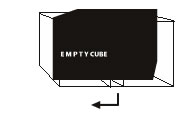ANA PERÉZ-QUIROGA
JANUARY, 22, 2009

CONTACT
anaperezquiroga@gmail.com
EXHIBITION INFORMATION
The BICYCLE'S NEAR-ROBBERY
variable size according to installation space
30 prints on 230gr Fabriano paper, 29x21cm each, with pencil inscription; stainless steel padlock; calling card; invoice/receipt; self-adhesive vinyl wall-text; pamphlets printed on 200 gr Fabriano paper.
News from Shanghai.
This project, brought by Ana Pérez-Quiroga to EMPTY CUBE, brings to an end an epistolary memory inscribed in the contacts we kept during her 2008 stay in Shanghai. I was always most excited by the news and pictures she sent me through that widespread and yet magical technology, the Internet. Even though these memories I am communicating to you here are personal and nothing more than a brief note, they nonetheless indicate a new development in this artist’s work, which has always incorporated memories, as well as recorded and written evocations. These memories are of various kinds, like objects she picks up or pilfers, small jotted-down stories, which she sometimes tells and are later included in her production, tickets, receipts and anything she may lay her hands on. Her relationship with the world implies a stance that is immersive and close to the daily life of wherever she may happen to be, for a long or short period of time. The use of a reference or evocation is indicative of her interest in certain situations or moments, which she draws into her powerfully self-referential and poetical work. And I suspect that Rimbaud floats under her persona, her being-another as an artist in constant ethnographic wanderings.
The previously mentioned new development brings to us, in this project, a new side to Pérez-Quiroga’s oeuvre, which combines with shrewd efficiency three tools that are central to her work: language, her collecting habits and record-keeping. This latter has taken the form of an unlikely diary, which the artist keeps with constant irregularity. It is within this context that “O quase golpe da bicicleta” [“The bicycle’s near-robbery] carries us into a possible fiction, in the sense that a personal story, lived by the artist herself, is conveyed by a set of pictures, a dated text, possibly taken from a diary, a wall-text and three objects. The pictures, evocative of a film sequence, that place us in the oriental city of Shanghai, were taken with the artist’s iPhone camera. The use of this device is itself indicative of the mobility Quiroga brings to her field work, turning it into a format that combines the heightened experience of the metropolis with the voracious urge to capture and communicate a succession of unexpected movements.
Let us go back again. Language is the prime tool Ana Pérez-Quiroga employs, with a fine, uncluttered sense of irony, to create a structure that disrupts the seemingly straightforward recording of the experience described in the text. The word “near”, used in the title, both subverts the probable end of the narrative and forewarns us about it, taking us into the centre of the artist’s action, which transcends the mere reporting of an event. Similarly, the diary page, taken from a moment in her life experience, is actually the only written page of that imaginary document. In much the same way, her digital photographs (single prints) are printed on heavy, high-quality paper (230 gr Fabriano), traditionally used for drawing and watercolour paintings, thus becoming a metaphor and an appropriation of classic techniques and media from art history. The artist employs an operative strategy to explore her personal experiences in the public sphere, weaving over her everyday living a web that interconnects intimacy, desire and the artist’s experience of others as the object and material of her work. She may equally resort to the revisitation of an object, triggered by the memory it evokes, or to a fictional construction disseminated across the pictures and the intimate, written thread of what could be an unlikely diary.
João Silvério
January 2009




